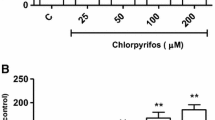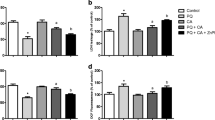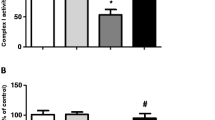Abstract
The antioxidant, anti-inflammatory, and anticancer activities of Withania somnifera (WS) are known for a long time. This study was aimed to examine whether WS also diminishes 4-hydroxy-trans-2-nonenal (HNE)-induced neurotoxicity in human neuroblastoma (SH-SY5Y) cell line. The cytotoxic response of HNE (0.1–50 μM) and WS (6.25–200 μg/ml) was measured by MTT assay after exposing SH-SY5Y cells for 24 h. Then neuroprotective potential was assessed by exposing the cells to biologically safe concentrations of WS (12.5, 25, and 50 μg/ml) then HNE (50 μM). Results showed a concentration-dependent protective effect of WS at 12.5, 25, and 50 μg/ml against HNE (50 μM) induced cytotoxicity and cell inhibition. Pre-exposure to WS resulted in a strong inhibition of 24, 55 and 83% in malondialdehyde (MDA) level; 5, 27 and 60% in glutathione (GSH) level; 12, 36 and 68% in catalase activity; 11, 33 and 67% in LDH leakage; and 40, 80 and 120% in cellular LDH activity at 12.5, 25, and 50 μg/ml, respectively, induced by 50 μM HNE in SH-SY5Y cells. The HNE-mediated cellular changes (cell shrinkage, rounded bodies, and inhibition of outgrowth) and increased caspase-3 activity were also prevented by WS. The HNE-induced upregulation of proapoptotic markers (p53, caspase-3, and -9, and Bax) and downregulation of antiapoptotic marker Bcl-2 genes were also blocked by pretreatment with WS. Altogether, our findings indicate that WS possesses a protective potential against HNE-induced neurotoxicity.







Similar content being viewed by others
References
Ayala A, Muñoz MF, Argüelles S (2014) Lipid peroxidation: production, metabolism, and signaling mechanisms of malondialdehyde and 4-hydroxy-2-nonenal. Oxid Med Cell Longev 2014:360438
Vazdar M, Jurkiewicz P, Hof M, Jungwirth P, Cwiklik L (2012) Behavior of 4-hydroxynonenal in phospholipid membranes. J Phys Chem B 116(22):6411–6415
Mancuso M, Coppede F, Migliore L, Siciliano G, Murri L (2006) Mitochondrial dysfunction, oxidative stress and neurodegeneration. J Alzheimer’s Dis 10(1):59–73
Shichiri M (2014) The role of lipid peroxidation in neurological disorders. J Clin Biochem Nutr 54(3):151–160
Long EK, Picklo MJ Sr (2010) Trans-4-hydroxy-2-hexenal, a product of n-3 fatty acid peroxidation: make some room HNE. Free Radic Biol Med 49(1):1–8
Abarikwu SO, Farombi EO, Pant AB (2011) Biflavanone-kolaviron protects human dopaminergic SH-SY5Y cells against atrazine induced toxic insult. Toxicol In Vitro 25(4):848–858
Dalleau S, Baradat M, Gueraud F, Huc L (2013) Cell death and diseases related to oxidative stress: 4-hydroxynonenal (HNE) in the balance. Cell Death Differ 20(12):1615–3160
Wu PS, Yen JH, Kou MC, Wu MJ (2015) Luteolin and apigenin attenuate 4-hydroxy-2-nonenal-mediated cell death through modulation of UPR, Nrf2-ARE and MAPK pathways in PC12 cells. PLoS ONE 10(6):e0130599
Hytti M, Piippo N, Salminen A, Honkakoski P, Kaarniranta K, Kauppinen A (2015) Quercetin alleviates 4-hydroxynonenal-induced cytotoxicity and inflammation in ARPE-19 cells. Exp Eye Res 132:208–215
Li D, Gu Z, Zhang J, Ma S (2019) Protective effect of inducible aldo-keto reductases on 4-hydroxynonenal-induced hepatotoxicity. Chem Biol Interact 304:124–130
Esterbauer H, Schaur RJ, Zollner H (1991) Chemistry and biochemistry of 4-hydroxynonenal, malonaldehyde and related aldehydes. Free Radic Biol Med 11:81–128
Schneider C, Tallman KA, Porter NA, Brash AR (2001) Two distinct pathways of formation of 4-hydroxynonenal. Mechanisms of nonenzymatic transformation of the 9- and 13-hydroperoxides of linoleic acid to 4-hydroxyalkenals. J Biol Chem 276:20831–20838
Vaillancourt F, Fahmi H, Shi Q, Lavigne P, Ranger P, Fernandes JC, Benderdour M (2008) 4-Hydroxynonenal induces apoptosis in human osteoarthritic chondrocytes: the protective role of glutathione-S-transferase. Arthritis Res Ther 10(5):R107
Hortigón-Vinagre MP, Henao F (2014) Apoptotic cell death in cultured cardiomyocytes following exposure to low concentrations of 4-hydroxy-2-nonenal. Cardiovasc Toxicol 14(3):275–287
Siddiqui MA, Kashyap MP, Khanna VK, Yadav S, Pant AB (2010) NGF induced differentiated PC12 cells as in vitro tool to study 4-hydroxynonenal induced cellular damage. Toxicol In Vitro 24(6):1681–1688
Siddiqui MA, Kashyap MP, Kumar V, Al-Khedhairy AA, Musarrat J, Pant AB (2010) Protective potential of trans-resveratrol against 4-hydroxynonenal induced damage in PC12 cells. Toxicol In Vitro 24(6):1592–1598
Siddiqui MA, Singh G, Kashyap MP, Khanna VK, Yadav S, Chandra D, Pant AB (2008) Influence of cytotoxic doses of 4-hydroxynonenal on selected neurotransmitter receptors in PC-12 cells. Toxicol In Vitro 22(7):1681–1688
Zhang W, He Q, Chan LL, Zhou F, El Naghy M, Thompson EB, Ansari NH (2001) Involvement of caspases in 4-hydroxy-alkenal–induced apoptosis in human leukemic cells. Free Radic Biol Med 30(6):699–706
Kutuk O, Poli G, Basaga H (2006) Resveratrol protects against 4-hydroxynonenal-induced apoptosis by blocking JNK and c-JUN/AP-1 signaling. Toxicol Sci 90(1):120–132
Kruman I, Bruce-Keller AJ, Bredesen D, Waeg G, Mattson MP (1997) Evidence that 4-hydroxynonenal mediates oxidative stress-induced neuronal apoptosis. J Neurosci 17(13):5089–5100
Lovell MA, Ehmann WD, Mattson MP, Markesbery WR (1997) Elevated 4-hydroxynonenal in ventricular fluid in Alzheimer’s disease. Neurobiol Aging 18(5):457–461
Markesbery WR, Lovell MA (1998) Four-hydroxynonenal, a product of lipid peroxidation, is increased in the brain in Alzheimer’s disease. Neurobiol Aging 19(1):33–36
Shoeb M, Ansari H, N, K Srivastava S, V Ramana K, (2014) 4-Hydroxynonenal in the pathogenesis and progression of human diseases. Curr Med Chem 21(2):230–237
Castellani RJ, Perry G, Siedlak SL, Nunomura A, Shimohama S, Zhang J, Montine T, Sayre LM, Smith MA (2002) Hydroxynonenal adducts indicate a role for lipid peroxidation in neocortical and brainstem Lewy bodies in humans. Neurosci Lett 319(1):25–28
Vatassery GT (1998) Vitamin E and other endogenous antioxidants in the central nervous system. Geriatrics 53(Suppl 1):S25–S27
Kumar GP, Khanum F (2012) Neuroprotective potential of phytochemicals Pharmacogn Rev 6(12):81–90
Liu D, Du D (2020) Mulberry fruit extract alleviates cognitive impairment by promoting the clearance of Amyloid-β and inhibiting neuroinflammation in Alzheimer’s disease mice. Neurochem Res. https://doi.org/10.1007/s11064-020-03062-7
Venuprasad MP, Kumar KH, Khanum F (2013) Neuroprotective effects of hydroalcoholic extract of Ocimum sanctum against H2O2 induced neuronal cell damage in SH-SY5Y cells via its antioxidative defence mechanism. Neurochem Res 38(10):2190–2200
Wu WR, Zhu XZ (1999) Involvement of monoamine oxidase inhibition in neuroprotective and neurorestorative effects of Ginkgo biloba extract against MPTP-induced nigrostriatal dopaminergic toxicity in C57 mice. Life Sci 65(2):157–164
Chen H, Jing FC, Li CL, Tu PF, Zheng QS, Wang ZH (2007) Echinacoside prevents the striatal extracellular levels of monoamine neurotransmitters from diminution in 6-hydroxydopamine lesion rats. J Ethnopharmacol 114(3):285–289
de Oliveria DM, Barreto G, De Andrade DV, Saraceno E, Aon-Bertolino L, Capani F, El Bachá RD, Giraldez LD (2009) Cytoprotective effect of Valeriana officinalis extract on an in vitro experimental model of Parkinson disease. Neurochem Res 34(2):215–220
Alvira D, Yeste-Velasco M, Folch J, Verdaguer E, Canudas AM, Pallas M, Camins A (2007) Comparative analysis of the effects of resveratrol in two apoptotic models: inhibition of complex I and potassium deprivation in cerebellar neurons. Neuroscience 147(3):746–756
Ojha RP, Rastogi M, Devi BP, Agrawal A, Dubey GP (2012) Neuroprotective effect of curcuminoids against inflammation-mediated dopaminergic neurodegeneration in the MPTP model of Parkinson’s disease. J Neuroimmune Pharmacol 7(3):609–618
Tripanichkul W, Jaroensuppaperch EO (2012) Curcumin protects nigrostriatal dopaminergic neurons and reduces glial activation in 6-hydroxydopamine hemiparkinsonian mice model. Int J Neurosci 122(5):263–270
Kpamk L, Dharmadasa RM, Samarasinghe K, Muthukumarana PR (2015) Comparative pharmacognostic study of different parts of Withania somnifera and its substitute ruellia tuberosa. World J Agric Res 3:28–33
Prakash J, Yadav SK, Chouhan S, Singh SP (2013) Neuroprotective role of Withania somnifera root extract in Maneb-Paraquat induced mouse model of parkinsonism. Neurochem Res 38(5):972–980
Rai M, Jogee PS, Agarkar G, Santos CA (2016) Anticancer activities of Withania somnifera: Current research, formulations, and future perspectives. Pharma Biol 54(2):189–197
Sivamani S, Joseph B, Kar B (2014) Anti-inflammatory activity of Withania somnifera leaf extract in stainless steel implant induced inflammation in adult zebrafish. J Gene Eng Biotechnol 12(1):1–6
Tiwari S, Sahni YP (2012) Anti-stress activity of Withania somnifera (Ashwagandha) on solar radiation induced heat stress in goats. Indian J Small Rum 18(1):64–68
Bhattacharya SK, Muruganandam AV (2003) Adaptogenic activity of Withania somnifera: an experimental study using a rat model of chronic stress. Pharmacol Biochem Behav 75(3):547–555
Khan MA, Ahmed RS, Chandra N, Arora VK, Ali A (2019) In vivo, Extract from Withania somnifera root ameliorates arthritis via regulation of key immune mediators of inflammation in experimental model of Arthritis. Antiinflamm Antiallergy Agents Med Chem 18(1):55–70
Davis L, Kuttan G (2000) Immunomodulatory activity of Withania somnifera. J Ethnopharmacol 71(1–2):193–200
Dar NJ, Hamid A, Ahmad A (2015) Pharmacologic overview of Withania somnifera, the Indian Ginseng. Cell Mol Life Sci 72:4445–4460
Kaur G, Kaur T, Gupta M, Manchanda S (2017) Neuromodulatory role of Withania somnifera. Inscience of Ashwagandha: preventive and therapeutic potentials. Springer, Cham 2017:417–436
Mehta AK, Binkley P, Gandhi SS, Ticku MK (1991) Pharmacological effects of Withania somnifera root extract on GABAA receptor complex. Indian J Med Res 94:312–315
Nagashayana N, Sankarankutty P, Nampoothiri MR, Mohan PK, Mohanakumar KP (2000) Association of L-DOPA with recovery following Ayurveda medication in Parkinson’s disease. J Neurol Sci 176(2):124–127
Andrade C, Aswath A, Chaturvedi SK, Srinivasa M, Raguram R (2000) A doubleblind placebo-controlled evaluation of anxiolytic efficacy of an ethanolic extract of Withania somnifera. Indian J Psychiatry 42:295–301
Kulkarni SK, Dhir A (2008) Withania somnifera: an Indian ginseng. Prog Neuropsychopharmacol Biol Psychiatry 32(5):1093–1105
Prabu PC, Panchapakesan S, Raj CD (2013) Acute and sub-acute oral toxicity assessment of the hydroalcoholic extract of Withania somnifera roots in Wistar rats. Phytotherapy Res 27(8):1169–1178
Patel SB, Rao NJ, Hingorani LL (2016) Safety assessment of Withania somnifera extract standardized for Withaferin A: acute and sub-acute toxicity study. J Ayurveda Integr Med 7(1):30–37
Chandrasekhar K, Kapoor J, Anishetty S (2012) A prospective, randomized double-blind, placebo-controlled study of safety and efficacy of a high-concentration full-spectrum extract of ashwagandha root in reducing stress and anxiety in adults. Indian J Psychol Med 34(3):255–262
Attoff K, Kertika D, Lundqvist J, Oredsson S, Forsby A (2016) Acrylamide affects proliferation and differentiation of the neural progenitor cell line C17.2 and the neuroblastoma cell line SH-SY5Y. Toxicol In Vitro 35:100–111
Lopes FM, Schröder R, da Frota Júnior ML, Zanotto-Filho A, Müller CB, Pires AS, Meurer RT, Colpo GD, Gelain DP, Kapczinski F, Moreira JC (2010) Comparison between proliferative and neuron-like SH-SY5Y cells as an in vitro model for Parkinson disease studies. Brain Res 1337:85–94
Martínez MA, Rodríguez JL, Lopez-Torres B, Martínez M, Martínez-Larrañaga MR, Maximiliano JE, Anadón A, Ares I (2020) Use of human neuroblastoma SH-SY5Y cells to evaluate glyphosate-induced effects on oxidative stress, neuronal development and cell death signaling pathways. Environ Intern 135:105414
Pant AB, Agarwal AK, Sharma VP, Seth PK (2001) In vitro cytotoxicity evaluation of plastic biomedical devices. Hum Exp Toxicol 20:412–417
Buege JA, Aust SD (1978) Microsomal lipid peroxidation. Methods Enzymol 52:302–310
Sedlak J, Lindsay RH (1968) Estimation of total, protein-bound and non-protein sulfhydryl groups in tissue with Ellman’s reagent. Anal Biochem 25:192–205
Sinha AK (1972) Colorimetric assay of catalase. Anal Biochem 47:389–394
Wang H, Joseph JA (1999) Quantifying cellular oxidative stress by dichlorofluorescein assay using microplate reader. Free Radic Biol Med 27(5–6):612–616
Al-Oqail MM, Al-Sheddi ES, Al-Massarani SM, Siddiqui MA, Ahmad J, Musarrat J, Al-Khedhairy AA, Farshori NN (2017) Nigella sativa seed oil suppresses cell proliferation and induces ROS dependent mitochondrial apoptosis through p53 pathway in hepatocellular carcinoma cells. S Afr J Bot 112:70–78
Fukuda M, Kanou F, Shimada N, Sawabe M, Saito Y, Murayama S, Hashimoto M, Maruyama N, Ishigami A (2009) Elevated levels of 4-hydroxynonenal-histidine Michael adduct in the hippocampi of patients with Alzheimer’s disease. Biomed Res 30(4):227–233
Akude E, Zherebitskaya E, Chowdhury SK, Girling K, Fernyhough P (2010) 4-Hydroxy-2-nonenal induces mitochondrial dysfunction and aberrant axonal outgrowth in adult sensory neurons that mimics features of diabetic neuropathy. Neurotox Res 17(1):28–38
Carrera I, Cacabelos R (2019) Current drugs and potential future neuroprotective compounds for parkinson’s disease. Curr Neuropharmacol 17(3):295–306
Bharathi MD, Justin-Thenmozhi A, Manivasagam T, Rather MA, Babu CS, Essa MM, Guillemin GJ (2019) Amelioration of aluminum maltolate-induced inflammation and endoplasmic reticulum stress-mediated apoptosis by tannoid principles of emblica officinalis in neuronal cellular model. Neurotox Res 35(2):318–330
Kasture S, Vinci S, Ibba F, Puddu A, Marongiu M, Murali B, Pisanu A, Lecca D, Zernig G, Acquas E (2009) Withania somnifera prevents morphine withdrawal-induced decrease in spine density in nucleus accumbens shell of rats: a confocal laser scanning microscopy study. Neurotox Res 16(4):343–355
Kumar S, Seal CJ, Howes MJ, Kite GC, Okello EJ (2010) In vitro protective effects of Withania somnifera (L) dunal root extract against hydrogen peroxide and β-amyloid induced cytotoxicity in differentiated PC12 cells. Phytother Res 24(10):1567–1574
Raza H, Robin MA, Fang JK, Avadhani NG (2002) Multiple isoforms of mitochondrial glutathione S-transferases and their differential induction under oxidative stress. Biochem J 366(1):45–55
Breitzig M, Bhimineni C, Lockey R, Kolliputi N (2016) 4-Hydroxy-2-nonenal: a critical target in oxidative stress? Am J Physiol Cell Physiol 311(4):C537-543
Birla H, Keswani C, Rai SN, Singh SS, Zahra W, Dilnashin H, Rathore AS, Singh SP (2019) Neuroprotective effects of Withania somnifera in BPA induced-cognitive dysfunction and oxidative stress in mice. Behav Brain Funct 15(1):9
Jayaprakasam B, Padmanabhan K, Nair MG (2010) Withanamides in Withania somnifera fruit protect PC-12 cells from β-amyloid responsible for Alzheimer’s disease. Phytother Res 24(6):859–863
Kim H-J, Song YJ, Park JH, Park H-K, Yun DH, Chung J-H (2009) Naringin protects against rotenone induced apoptosis in human neuroblastoma SH-SY5Y cells. Korean J Physiol Pharmacol 13:281–285
Raza H, John A (2006) 4-Hydroxynonenal induces mitochondrial oxidative stress, apoptosis and expression of glutathione S-transferase A4–4 and cytochrome P450 2E1 in PC12 cells. Toxicol Appl Pharmacol 216:309–318
France V, Hassan F, Qin S, Patrick L, Pierre R, Julio CF, Mohamed B (2008) 4- Hydroxynonenal induces apoptosis in human osteoarthritic chondrocytes: the protective role of glutathione-S-transferase. Arthritis Res Ther 10:R107
Acknowledgements
The authors are grateful to the Deanship of Scientific Research, King Saud University for funding through Vice Deanship of Scientific Research Chairs. The authors thank the Deanship of Scientific Research and RSSU at King Saud University for their technical support.
Author information
Authors and Affiliations
Contributions
MAS and ABP conceived and designed the research. MAS, NNF and MMA conducted the experimental work. ABP and AAA provided reagents and tools in the laboratory. MAS, ABP and AAA analyzed the data. MAS and NNF wrote the manuscript. All authors have read and approved the manuscript.
Corresponding author
Ethics declarations
Conflict of interest
The authors declare that they have no conflicts of interest.
Ethical Approval
This paper does not contain any studies with human or animals.
Additional information
Publisher's Note
Springer Nature remains neutral with regard to jurisdictional claims in published maps and institutional affiliations.
Rights and permissions
About this article
Cite this article
Siddiqui, M.A., Farshori, N.N., Al-Oqail, M.M. et al. Neuroprotective Effects of Withania somnifera on 4-Hydroxynonenal Induced Cell Death in Human Neuroblastoma SH-SY5Y Cells Through ROS Inhibition and Apoptotic Mitochondrial Pathway. Neurochem Res 46, 171–182 (2021). https://doi.org/10.1007/s11064-020-03146-4
Received:
Revised:
Accepted:
Published:
Issue Date:
DOI: https://doi.org/10.1007/s11064-020-03146-4




